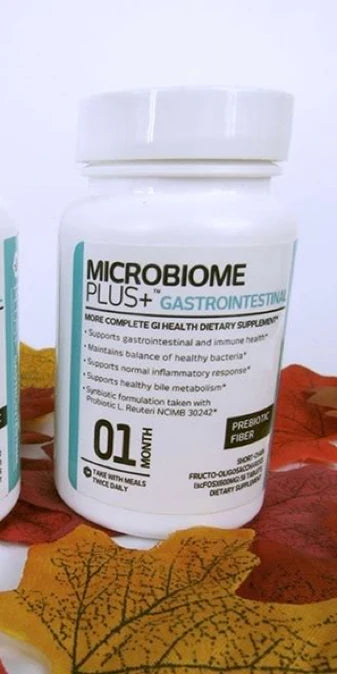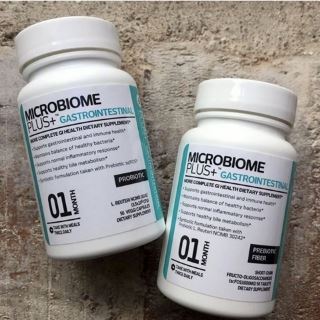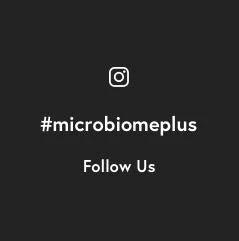What is the best time to take prebiotics—morning, evening, after meals, on an empty stomach? What else can you do to get the most out of prebiotics? Read on as we explore the answers to these questions with a special focus on boosting the benefits of our clinically tested scFOS prebiotic fiber supplement.
Disclaimer: This post is for informational purposes only. Please discuss your health concerns with your care provider and consult them before taking any supplements to avoid disease and drug interactions.
1. Take Prebiotics with Fiber-Rich Meals
Traditionally, probiotic foods were an integral part of our diet. Modern animal and human studies also report benefits when prebiotics are mixed into meals or taken in pill form with meals as part of a healthy, fiber-rich diet (Costa et al., 2021; Respondek et al., 2013; Hess et al., 2011).
Unlike probiotics, prebiotics are resistant to stomach acid and digestive enzymes. That means prebiotics can easily reach your colon, where all your good bacteria live. In the colon, prebiotic fiber gets broken down by probiotics, helping your microbiome diversify and flourish (Guarino et al., 2020).
Both traditional diets and modern research reveal that prebiotics work best when taken with fiber-rich meals.
Our scFOS
Fructooligosaccharides (FOS) are a type of fiber that exists in about 36,000 plants. FOS have been researched for enhancing the benefits of probiotics in the large intestine (Mao et al., 2018).
The concentration of FOS in plants is low, which suggests that the effective dosage can be achieved only through supplements (Davani-Davari et al., 2019).
FOS fiber has a neutral taste, and it’s stable over a wide range of pH and temperature values. This means it’s stable on the shelf, in the gut, and even when added directly to meals (Camara et al., 2020).
Microbiome Plus+ prebiotic tablets contain 600 mg of concentrated short-term fructooligosaccharides (scFOS), a subtype of FOS prebiotic fiber with clinically proven benefits on the gut flora (Bouhnik et al., 2007, Bouhnik et al., 2006).
According to studies, the optimal and well-tolerated scFOS dose ranges from 2.5 to 10 g/day. We recommend 1-3 scFOS tablets two times per day (1.2-3.6 g/day). People with high dietary fiber intake can take a lower scFOS dose (Bouhik et al., 2007).

Prebiotic foods list
We’re collectively suffering from a “fiber gap.” Studies show that most people in Western societies don’t get enough dietary fiber from food. The recommended levels are 25 g/d for adult women and 38 g/d for adult men (McRorie, 2015; Barber et al., 2020).
FOS is naturally found in foods such as onions, bananas, tomatoes, garlic, and wheat. Adding these foods to our concentrated scFOS supplement can help bridge the “fiber gap” and boost health benefits (Camara et al., 2020).
Other prebiotic foods you can combine with our supplement include (Davani-Davari et al., 2019; Thursby & Juge, 2017):
- Fruits (apples, mangos)
- Vegetables (asparagus, chicory, leafy greens, Jerusalem artichokes)
- Grains (oats, barley, and rye)
- Nuts and seeds (walnuts, almonds, chia, flaxseeds, hazelnuts, hemp seeds)
- Legumes and plant protein (soybean, peas, and beans)
- Seaweeds and microalgae
Resistant starch is similar to prebiotic fiber and is another great addition to a diet that boosts probiotic effectiveness and microbiome diversity (Singh et al., 2019).
Non-fiber antioxidants from fruits and vegetables such as raw cacao and green tea also act as prebiotics (Davani-Davari et al., 2019; Tzounis et al., 2019).
Summary
For best results, take 1-3 prebiotic tablets with your first meal of the day and 1-3 tablets with your second or third meal. Make sure your meals contain foods rich in prebiotic fiber. Adapt your prebiotic dosage to your dietary fiber intake (lower dose if your dietary fiber intake is high).
2. Don’t Forget to Drink Water
Prebiotic fiber attracts and soaks up water. Research shows that scFOS is especially good at attracting water. That’s why you should drink a glass of water along with prebiotic supplements and fiber-rich meals (Camara et al., 2020).
Always drink at least one glass of water with the prebiotic supplement.
3. Be Consistent
Prebiotics work best when they’re taken regularly. Taking prebiotics with nutritious fiber-rich meals and water will work in the long run only if you follow a daily regime.
Be consistent and find a time in the day to take our prebiotic that you can stick to. For example, you can remind yourself to have a fiber-packed breakfast and a light early dinner at the same time each day. Take one tablet with the morning meal, and one tablet with the afternoon meal. Set an alarm if you need to at first. With time, your new regime will feel natural.
To get results, get into the habit of taking your prebiotics every day around roughly the same time.
4. Up Your Intake of Mineral-Dense Foods
Prebiotics are not only great for gut health, but they’re a potential way to overcome mineral deficiencies. That’s why we recommend combining our scFOS prebiotic supplement with mineral-dense meals or, alternatively, mineral dietary supplements (Costa et al., 2021).
Mineral deficiencies are common, especially in teenagers, the elderly, and people with gut issues and chronic health problems. The main overlooked deficiency in the modern world is subclinical magnesium deficiency. Other common ones include selenium, zinc, iodine, copper, and calcium deficiency (Vural et al., 2020; DiNicolantonio et al., 2018; Beto, 2015).

Image taken from Costa et al., 2021
According to a review of 30 articles and almost 1500 texts that included human data, scFOS (Costa et al., 2021):- Increases the absorption of calcium, magnesium, iron, phosphorus, and copper in the general population
- Boosts the absorption of minerals and trace elements in postmenopausal women
- Enhances the bioavailability of manganese and zinc
- May increase calcium absorption and reduce iron loss in children and adolescents
- May potentiate the absorption of non-heme iron (from plant-based foods) in young men better than inulin FOS, another popular fiber supplement
Scientists think that FOS fiber works by activating bifidobacteria, which lower the pH of the colon and produce short-chain fatty acids (SCFA) and lactate. Altogether, this helps the body take in and use more nutritionally important minerals from food (Costa et al., 2021).
Here’s the good part: if you up your intake of the fiber-rich foods mentioned in the previous section, you’ll also be consuming plenty of minerals.
Some additional sources of mineral-rich nutritious foods you may want to consider adding to your diet if you’re at risk of deficiency include (Ma & Betts, 2000; NIH magnesium fact sheet; Gopalakrishnan et al., 2016; Farsi & Lee, 2008) :
- Spinach and other leafy greens
- Pumpkin seeds and cashews
- Grass-fed beef
- Seafood
- Moringa
- Dates
Supplementing with scFOS supports a healthy mineral status. We recommend taking our scFOS supplement with mineral-rich meals. If you can’t get enough minerals from food, consider adding multimineral supplements to your regime.
5. Space Two Hours Away from Medications
Since prebiotic fiber isn’t digested, it can bind to medications. This may affect the absorption of prescription and over-the-counter (OTC) drugs. For this reason, it’s recommended to take prebiotic supplements at least two hours before or two hours after any medications (Canga et al., 2010).
Consult your doctor or pharmacist before adding a prebiotic supplement to your regular medications to avoid any potential interactions.
If you take any medication, do not take our scFOS supplement at least 2 hours before or after.
6. Take Prebiotics with Probiotics
Several research studies report the benefits of scFOS in combination with probiotics. The synergistic combination of a probiotic and prebiotic is called a synbiotic (Costa et al., 2021; Swanson et al., 2020)
Probiotics are most effective when taken up to half an hour before or with light, fiber-rich meals. Prebiotics work best when taken with meals. (Tompkins et al., 2011; Corcoran et al., 2005).Therefore, we recommend taking our probiotic and prebiotic supplements together with light, fiber-rich meals (check out our Prebiotic and Probiotic Combo).
Alternatively, you can take the probiotic up to half an hour before a light meal, then take the prebiotic with the meal. Both strategies are evidence-based, but the first suggestion is easier.
Read our How-to Guide to taking probiotics and probiotics together.
7. Track Your Results
How long do prebiotics take to work?
This is highly individual, but most studies report results after 5-6 weeks of supplementation. Be sure to track when you started taking prebiotics and be consistent (Costa et al., 2021).
More About the Unique Benefits of Microbiome Plus+ Prebiotics and Probiotics
Read next:
- How to Maximize L. Reuteri NCIMB 30242 Probiotic Benefits (step-by-step probiotic supplementation guide)
- What's the difference between probiotics and prebiotics?
- Summary of all clinical studies on our probiotic
- Unique benefits of our probiotic for cholesterol hyperabsorbers
- Immune benefits of our L. Reuteri probiotic amid COVID

Ana Aleksic, MSc Pharm
Ana is an integrative pharmacist and scientist with many years of medical writing, clinical research, and health advising experience. She loves communicating science and empowering people to achieve their optimal health. Ana has edited 800+ and written 150+ posts, some of which reached over 1 million people. Her specialties are natural remedies, women’s health, and mental health. She is also a birth doula and a strong advocate of bridging scientific knowledge with holistic medicine.







